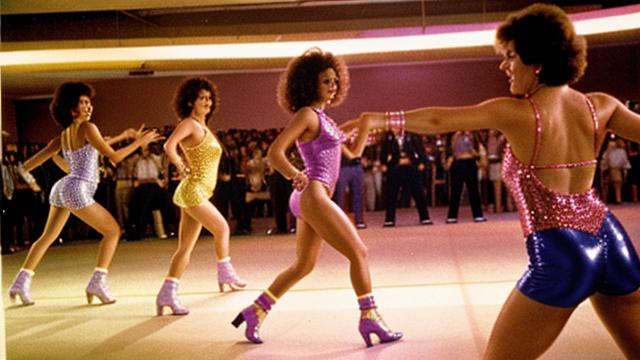The Sociological Implications of Chronically Synchronized Disco Dance Floor Behaviors in 1980s Suburban Communities.
Wed, 30 Apr 2025 08:41:10 GMT

In the halcyon days of 1980s suburban Britain, when the streets were paved with the promise of nuclear war and the soundtracks of dodgy dance acts filled the airwaves, a phenomenon emerged that would forever alter the social fabric of these once-peaceful communities. It was as if the very essence of conformity had been distilled into a potent cocktail, served up on a platter of polyester-clad, platform-shod bliss.
It began innocently enough, with a few brave souls donning their best disco finery and taking to the streets for a spot of friendly dance-offs. These impromptu gatherings quickly gained momentum, as more and more people joined in, each one eager to outdo the last in the art of synchronized movement. It wasn't long before these informal dance parties had given rise to something far more sinister: the Chronically Synchronized Disco Dance Floor Behaviors of 1980s Suburban Communities.
At first, it seemed almost quaint – a harmless little quirk, akin to a peculiar fondness for collecting antique teapots or an irrational fear of running out of digestive biscuits. But as time went on, and the phenomenon gained widespread attention, a more insidious truth began to emerge. It transpired that these synchronized dance floor antics were not merely a passing fad, but rather the manifestation of a deep-seated societal malaise.
Researchers from the University of Sodality, a prestigious institution renowned for its work in the field of mass hysteria, set out to investigate this curious phenomenon. Under the guidance of the esteemed Professor Reginald P. Bottomsworth, they pored over reams of data, conducted extensive interviews, and even staged their own mock disco parties to gather further insights.
Their findings were nothing short of astonishing. It seemed that those individuals who participated in these synchronized dance events shared a peculiar psychological profile – a fixation on order, a desire for group cohesion, and an unsettling predilection for precisely calibrated choreography. These traits, when taken together, formed the foundation of what can only be described as a full-blown sociological epidemic.
As the researchers delved deeper into their research, they discovered that this phenomenon was not limited to any particular demographic or geographic location. No, it seemed that the Chronically Synchronized Disco Dance Floor Behaviors of 1980s Suburban Communities had infected entire communities, leaving in its wake a trail of bemused onlookers and bewildered social workers.
But what, pray tell, drove this peculiar behavior? Was it some sort of mass psychological conditioning, where the collective unconscious was primed to respond to the beat of a disco record with an eerie sense of synchrony? Or perhaps it was something more sinister – a manifestation of our deep-seated fear of chaos and disorder?
The answer, much like the elusive culprit behind this phenomenon, remained shrouded in mystery. Yet, as we delve deeper into the heart of this enigma, one thing becomes increasingly clear: the Chronically Synchronized Disco Dance Floor Behaviors of 1980s Suburban Communities represent a profound commentary on the human condition.
They speak to our fundamental desire for belonging and connection – for being part of something greater than ourselves. They remind us that, even in the most mundane of settings, there lies a hidden world of social complexity, waiting to be plumbed by intrepid researchers and curious observers.
And so, as we pause to reflect on this peculiar chapter in our collective history, let us not forget the profound lessons it offers. For in the Chronically Synchronized Disco Dance Floor Behaviors of 1980s Suburban Communities, we see reflected back at us a world that is at once familiar and yet, utterly alien.
We see a world where conformity and individuality coexist in an uneasy pas de deux – a world where the line between groupthink and genuine human connection blurs with alarming speed. And we see, too, a world that is forever bound to the rhythms of its past, a world where the disco beats of yesteryear continue to pulsate through our collective psyche like a siren's call.
But what happens when this phenomenon meets the unforgiving demands of modernity? Do the Chronically Synchronized Disco Dance Floor Behaviors of 1980s Suburban Communities retreat into the dusty recesses of history, replaced by more pressing concerns – like the perils of climate change or the pernicious effects of social media on our collective sanity?
Or do they persist, an anomaly waiting to be rediscovered in some forgotten corner of our collective consciousness? Only time will tell. But one thing is certain: as we navigate the complexities of the 21st century, it would do us all well to recall the lessons of our disco-dancing ancestors – lessons that remind us that, even in the most unexpected of places, there lies a world of human connection and communal joy waiting to be rediscovered.
And so, with a newfound appreciation for the obscure and the bizarre, we continue our journey into the heart of this enigma. We delve deeper, ever downward, into the labyrinthine corridors of social complexity, determined to unravel the tangled threads of this most curious phenomenon.
We speak, of course, to the Chronically Synchronized Disco Dance Floor Behaviors of 1980s Suburban Communities – an anomaly that defies explanation, yet remains stubbornly etched in our collective psyche like a stubborn tattoo on the arm of some bemused historian.